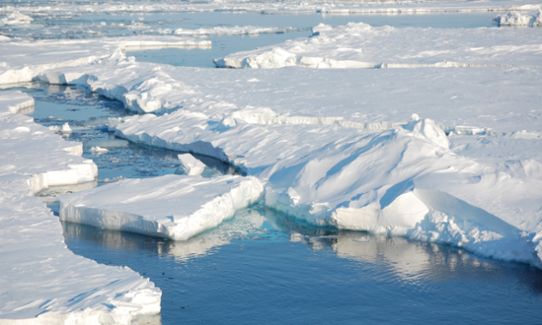The research team has analyzed recent results from 40 different climate models. Using these models, the researchers considered the future evolution of Arctic sea-ice cover in a scenario with high future CO2 emissions and little climate protection. As expected, Arctic sea ice disappeared quickly in summer in these simulations. However, the new study finds that Arctic summer sea ice also disappears occasionally if CO2 emissions are rapidly reduced.
"If we reduce global emissions rapidly and substantially, and thus keep global warming below 2 °C relative to preindustrial levels, Arctic sea ice will nevertheless likely disappear occasionally in summer even before 2050. This really surprised us," said Dirk Notz, who leads the sea-ice research group at University of Hamburg, Germany.

Currently, the North Pole is covered by sea ice year round. Each summer, the area of the sea ice cover decreases, in winter it grows again. In response to ongoing global warming, the overall area of the Arctic Ocean that is covered by sea ice has rapidly been reduced over the past few decades. This substantially affects the Arctic ecosystem and climate. The sea-ice cover is a hunting ground and habitat for polar bears and seals, and keeps the Arctic cool by reflecting sunlight.
How often the Arctic will lose its sea-ice cover in the future critically depends on future CO2 emissions, the study shows. If emissions are reduced rapidly, ice-free years only occur occasionally. With higher emissions, the Arctic Ocean will become ice free in most years. Hence, humans still have an impact on how often the Arctic loses its year-round sea-ice cover.
SMHI contribution to the study
Researchers from the SMHI Rossby Centre have contributed to the study with simulations from the updated version of the global climate model EC-Earth. This latest model version contains improvements in the description of the Arctic sea ice. This recreates a much more realistic annual cycle for the climate in the Arctic and an improved reproduction of the observed sea ice trends in the last 40 years.
– In this study, we showed that the most recent climate models are generally better than their predecessors in simulating the observed decline of Arctic sea ice for a given amount of CO2 emissions. However, the spread in the responses given by the different models remains high, meaning that a lot of uncertainties in the sea ice future projections exist. Despite these uncertainties, this study confirms that the Arctic may become ice free in summer by the middle of this century, which would have consequences for the global climate, said David Docquier, researcher at the SMHI Rossby Centre.
Continuous model improvements and updated simulations are essential to ensure that the latest scientific knowledge is always available to stakeholders in the society.
– This study with 40 updated climate models confirms the latest results from our own model EC-Earth, which shows a substantially faster sea ice reduction than our previous model version, said Torben Königk, head of the global modelling group at the SMHI Rossby Centre.